Abstract
In recent decades, there have been significant research efforts focusing on wireless indoor localization systems, with fingerprinting techniques based on received signal strength leading the way. The majority of the suggested approaches require challenging and laborious Wi-Fi site surveys to construct a radio map, which is then utilized to match radio signatures with particular locations. In this paper, a novel next-generation cyber-physical wireless indoor positioning system is presented that addresses the challenges of fingerprinting techniques associated with data collection. The proposed approach not only facilitates an interactive digital representation that fosters informed decision-making through a digital twin interface but also ensures adaptability to new scenarios, scalability, and suitability for large environments and evolving conditions during the process of constructing the radio map. Additionally, it reduces the labor cost and laborious data collection process while helping to increase the efficiency of fingerprint-based positioning methods through accurate ground-truth data collection. This is also convenient for working in remote environments to improve human safety in locations where human access is limited or hazardous and to address issues related to radio map obsolescence. The feasibility of the cyber-physical system design is successfully verified and evaluated with real-world experiments in which a ground robot is utilized to obtain a radio map autonomously in real-time in a challenging environment through an informed decision process. With the proposed setup, the results demonstrate the success of RSSI-based indoor positioning using deep learning models, including MLP, LSTM Model 1, and LSTM Model 2, achieving an average localization error of m in individual areas. Specifically, LSTM Model 2 achieves an average localization error as low as m and m with and of the errors within 2 m for individual and combined areas, respectively. These outcomes demonstrate that the proposed cyber-physical wireless indoor positioning approach, which is based on the application of dynamic Wi-Fi RSS surveying through human feedback using autonomous mobile robots, effectively leverages the precision of deep learning models, resulting in localization performance comparable to the literature. Furthermore, they highlight its potential for suitability for deployment in real-world scenarios and practical applicability.
1. Introduction
Indoor positioning systems are an essential part of location-aware applications and services in indoor environments, enabling localization, tracking, and monitoring of assets. These systems have diverse applications across various domains, including factory logistics, healthcare, asset tracking in office environments [1,2], medical equipment [3], and patients [4], as well as monitoring indoor activities and optimizing processes and resource allocations [5]. They also enable the delivery of location-based services, such as providing recommendations to tourists [6], assisting customers in navigating in indoor environments [7], and offering directions in shopping malls [8]. To meet these demands, extensive research has been conducted, utilizing a range of technologies such as visual [9], geometric [10,11], ultrasonic [12], and RF-based sensors [13,14].
The wireless local area network (WLAN) positioning method is one of the most commonly used RF-based techniques for indoor positioning. It relies on the characteristics of wireless signals, such as the angle of arrival (AOA), time of arrival (TOA), and received signal strength (RSS) based on the transmit-receive relationship of radio signals, without requiring connection to Wi-Fi networks [15]. However, modeling the relationship between RSS and position is challenging due to environmental constraints, including multipath interference or non-line-of-sight (NLOS) conditions. These factors can cause unpredictable signal propagation and random variations of RSS samples, even at fixed positions [16]. Furthermore, to tackle challenges like device height and heterogeneity, an approach involves manually adjusting RSS values for various testing devices using a linear transformation approach, incorporating diverse transformation functions such as time-space sampling [17], Kullback–Leibler divergence [18], and the Gaussian fit sensor model [19]. Because simple linear relationships may not effectively characterize the difference across mobile devices [18], researchers also introduce calibration-free methods where a new type of fingerprint is generated using absolute RSS values. For instance, RSS differences (signal strength difference) [20] and signal strength ratios [21] between pairs of access points (APs) serve as location fingerprints. Additionally, weighting schemes that consider the relationship of RSS values for each RSS are employed without extra calibration on test devices [22,23,24].
Fingerprint-based techniques [25,26] are a common approach for describing the relationship between RSS and position. These techniques rely on previously collected measurement data, particularly in multipath-rich fading indoor environments, as compared to distance-based trilateration and direction-based triangulation methods [27]. Therefore, accurate data collection is important for ensuring fingerprint-based techniques’ effectiveness and reliability to match radio signatures with specific locations. However, collecting data for fingerprint-based methods is a labor-intensive, time-consuming, and error-prone process, especially when working in large areas or scaling up systems [28].
The application of a smart space concept [29] to wireless indoor positioning can be applied to address the challenge of data collection by semi- or fully autonomously creating a radio map with digital twin (DT) integration. This approach can also overcome the scalability disadvantage of fingerprint-based systems [30,31] by providing a flexible and easily deployable system that can be integrated with existing network infrastructure. However, the implementation of a smart space setting involves cyber-physical systems (CPSs) infrastructure along with other requirements such as security, privacy, safety, and more [32]. CPSs are a new generation of integrated frameworks and mechanisms that enable the creation of living virtual DTs that replicate the behavior of their physical counterparts. These systems can improve efficiency, productivity, and collaborative working and enable the remote operation of complex physical systems [33]. This is facilitated through the combination of the Internet of Things (IoT) and twinning technologies, which not only provide simple synthetic representations but also enable synchronous bi-directional streaming of up-to-date data between the physical and digital spaces [34].
Considering cyber-physically in indoor positioning can also improve the efficiency and controllability of complex systems through intelligent human-machine interaction in cyberspace through a user interface [32]. Human operators can utilize DTs to remotely observe the real-time conditions in the operating environment and make better decisions. This capability can be particularly useful for identifying potential problems or opportunities for improvement, guiding better planning of the physical space, APs, and/or reference point (RP) layout decisions [35].
Contribution
This paper delivers new insights into wireless indoor positioning systems by approaching them from a cyber-physical perspective, focusing on fingerprinting techniques associated with data collection. This new proposed concept addresses challenging and laborious Wi-Fi site surveys to construct radio maps for a variety of indoor environments, such as modern smart buildings or digital workplaces, as well as challenging and demanding environments like nuclear facilities. In this regard, the research presents an innovative concept in wireless indoor positioning systems by adopting a cyber-physical approach with the following major contributions:
- We propose a cyber-physical wireless indoor positioning system framework to dynamically address the labor-intensive, time-consuming, error-prone construction of radio maps. This framework allows for regular radio map reconstruction and scalability of fingerprint-based positioning methods through dynamic Wi-Fi RSS surveying using (semi) autonomous mobile data collectors via digital twins.
- We develop a live synthetic 3D digital twin environment and user-friendly graphical user interface that incorporate human feedback in multiple ways, including the determination of reference point placement for fingerprint layout, facilitating safety-critical and remote missions, teleoperation of robots, and monitoring mission states and robot operations.
- We validate the feasibility of the proposed framework in a representative real-world nuclear environment and demonstrate the positioning performance of our framework using various deep learning algorithms.
2. Related Work
IoT and DT solutions are increasingly being employed to address indoor positioning challenges. This trend is expected to continue in the foreseeable future, as evidenced by a growing number of publication trends on IoT-based applications for indoor positioning, including review papers [36,37] and research articles (as shown in Table 1). Moreover, commercial DT services offered to various sectors have emerged alongside recent research activities [38,39,40,41,42].
Furthermore, research in the area of IoT and DT-enabled indoor positioning has pursued several avenues. Early work was primarily focused on the potential usefulness of the IoT concept for indoor positioning, rather than its practical applications. While some papers, such as [43,44,45], mentioned Industry 4.0 and IoT in their title or abstract, they did not discuss the development or practical implementation of these concepts. Table 1 presents a review of research articles that focus on implementing indoor positioning through IoT or DT infrastructure at different levels. Each paper is assessed and grouped by year, use case, the technology used, signal characteristics, indoor positioning techniques, context, interactivity, and application area. Additionally, each of them is evaluated based on different maturity levels of DT. These maturity levels include hierarchical naming conventions for data twin, asset twin, predictive twin, interactive twin, and cognitive twin [46,47].
As an example of IoT-based indoor positioning, Ref. [6] developed an indoor tracking system for tourism applications that tracks visitor activities and gathers information about their behavior and interests, such as the order in which they visit points of interest and the level of interest they exhibit for each. The system uses range-based trilateration and triangulation positioning techniques based on Bluetooth low energy (BLE)-based received signal strength indication (RSSI) to determine the level of proximity to each interest point rather than the precise location of a person. Although the study did not focus on interface or visualization, it did capture useful real-time analytics for each visitor and provided a tour report. Therefore, this study can be considered an example of a data twin in terms of the various maturity levels of DTs.

Table 1.
A review of indoor localization techniques in the literature through IoT and DT deployment.
Table 1.
A review of indoor localization techniques in the literature through IoT and DT deployment.
| Ref. ID | Year | Use-Case | Technology | Metric | Technique | Method | Context | Interaction | App.**Area |
|---|---|---|---|---|---|---|---|---|---|
| [48] | 2017 | Estimating region of interest | BLE | RSS | Localization | Fingerprint based | IoT | ✗ | Campus |
| [49] | 2020 | Analysis of visitor routes | BLE | RSS | Proximity and localization | Range based | IoT | ✗ | Museum |
| [6] | 2021 | Analysis of visitor routes | BLE | RSS | Proximity | Range based | IoT | ✗ | Tourism |
| [5] | 2021 | Asset tracking | BLE | RSS | Tracking | Range based | DT | ✗ | Industry and logistics |
| [1] | 2021 | Asset tracking | BLE | RSS | Localization | Fingerprint based | DT | ✗ | Industry and logistics |
| [2] | 2022 | Asset tracking | BLE and UWB | RSS | Tracking | Fingerprint based | IoT and DT | ✗ | Industry and logistics |
| [35] | 2022 | Occupancy and radio propagation analysis | UWB | TOA | Proximity and localization | Fingerprint based | DT | ✓ | Rectangular open area |
| Proposed | 2023 | Occupancy and radio propagation analysis | Wi-Fi | RSS | Tracking | Fingerprint based | CPS | ✓ | Rep.* nuclear environment |
* Representative, ** Application
Several researchers have focused on visualizing indoor positioning data and performing data analytics to enhance the traceability and visibility of physical objects, resulting in what is known as an asset twin. For instance, in Ref. [48], an IoT-based design is developed to identify locations within indoor environments. The design includes a dashboard interface, which allows users to gain insights into historical perceived data and estimated location results. In the study, two different fingerprint-based k-nearest neighbors (KNN) and K-means clustering classification algorithms are implemented using BLE-based RSSI.
Similarly, in Ref. [2], the implementation of industrial IoT and DT technology is introduced to facilitate the inspection, maintenance, and packaging processes of finished goods within a workshop setting. The study proposed a set of DT services, including a dynamic map, overtime alarm, and mobile application, to improve operational efficiency and enhance information traceability and visibility of physical objects. Moreover, the study proposed a long short-term memory (LSTM)-based indoor positioning system that uses both ultra-wideband (UWB) and BLE technologies to leverage the RSSI signal characteristics for real-time tracking of finished goods.
Furthermore, in Ref. [5], a comprehensive tool designed to support the integration of IoT and DT with indoor positioning systems is demonstrated. The study addresses communication technology, localization techniques, hardware components, and application design. The researchers developed an attendance management system that uses a BLE-based indoor positioning system, utilizing RSSI in the path loss model to track employees’ attendance and monitor their presence. The concept involves using employees’ smartphones as identification markers with an Android application.
However, aside from asset twins, few studies have investigated utilizing predictive or interactive capabilities to enhance recommendations for decision-making in indoor positioning applications by incorporating dynamic and recurring data reception. For instance, Ref. [49] developed an IoT-based indoor localization system to improve the user experience in a museum. The system provides valuable information about exhibits or collections by notifying nearby visitors through an Android application. It also collects useful analytics of each visit and offers recommendations to users based on their historical data. The trilateration method using BLE-based RSSI information, besides the Kalman filter, is implemented as a positioning algorithm. In terms of providing recommendations in addition to the user interface, this study may serve as an example of the next stage of DT, known as predictive twins.
Likewise, another study [1] proposes a DT-enabled framework for real-time indoor human safety tracking in airport cargo terminals. The framework visualizes and monitors the health status and location information of humans on a dashboard, predicting abnormal motionless behavior remotely for safety management. An algorithm for detecting abnormal motionless behavior and self-learning genetic positioning is developed using BLE-based RSSI in real-time. While these applications are successful in their respective fields, they are not yet true DTs because they lack bi-directional interaction or feedback to guide physical space decision-making.
An example of a bi-directional DT application with a feedback scheme is given in Ref. [35]. The study uses the propagation characteristics of UWB signals to analyze occupancy in a building with the help of DTs and then guides AP layout decision-making accordingly. This two-way communication enhances the planning of physical spaces, reduces NLOS situations, and results in improved positioning accuracy and increased value of DTs. The study also develops a fingerprint-based neural network positioning algorithm using the TOA signal characteristic of UWB. While this study is the first interactive and mature DT in the field of indoor positioning that we found, it is not clear from the paper how signal propagation or digitalization of occupancy analysis effectively aids AP location or DT visualization.
To summarize, the progression of DTs across the various stages has already begun for indoor positioning systems. Table 2 presents an assessment of the maturity of the current state of studies in terms of DT deployment. The stages progress from data twin to cognitive twin, meaning they advance from those that display only the current condition of an asset to those incorporating technologies for autonomous and adaptive self-enhancements in changing conditions. To the best of the authors’ knowledge, there have been no previous instances of cognitive twin development for indoor positioning systems. This study aims to fill this gap by proposing the development of cognitive twin capabilities. Specifically, it (1) employs autonomous Wi-Fi RSS surveying to dynamically construct radio and heat maps using mobile data collectors (e.g., robot(s)) with human-in-the-loop control through a user interface. This facilitates adaptation to new scenarios, changes in the environment, or AP locations. It will also make data collection easier to scale up and increase the efficiency of fingerprint-based positioning methods. Additionally, this study (2) develops a graphical user interface for visualizing, interacting with, and monitoring the cyber-physical indoor environment to minimize the need for human intervention and enable remote applications.

Table 2.
Various maturity levels of DT follow hierarchical naming conventions adapted from [46] for indoor positioning systems. "+" refers to inclusion, while "-" denotes exclusion.
For the rest of this paper, Section 3 describes the design methodology, defines the components of the cyber-physical wireless indoor positioning system, and provides an overview of the overall integration. In Section 4, the whole system is evaluated in an experimental setup, and the results are presented, while Section 5 concludes the study with a discussion.
3. Cyber-Physical Wireless Indoor Positioning System
This section presents the CPS infrastructure design methodology, an approach that tackles the operational and planning decision challenges associated with indoor positioning problems.
3.1. Problem Formulation
Existing fingerprint-based indoor positioning systems face several challenges and limitations. For instance, they often lack scalability, meaning that they are not easily adaptable to different environments and may not work effectively in large evolving spaces such as office buildings, shopping malls, airports, and hospitals. Furthermore, the reliance on human presence in these systems can result in increased labor costs, time-consuming processes, error-prone outcomes, and safety concerns, especially in extreme environments like nuclear facilities, where human access may be restricted or hazardous. Additionally, these systems lack situational awareness, which can hinder people’s ability to make informed decisions. In this regard, the following problem statements are defined.
- 1.
- Scalability. The system should be adaptable and applicable to diverse indoor settings as well as challenging remote environments.
- 2.
- Situational awareness. The system should augment situational awareness and support humans in making better decisions.
- 3.
- Minimize the reliance on human presence. The system should minimize human presence in the field to both lower the costs of labor related to data collection and improve the safety of personnel and facilities.
- 4.
- Precise and efficient data collection and model. The system should provide precise ground-truth data collection for accurate positioning methods.
- 5.
- Efficient communication network. The system should provide acceptable latency in updates to provide timely and actionable information for seamlessly integrating physical and digital spaces.
3.2. System Requirements
A UML use-case diagram, given in Figure 1, identifies system requirements of problem formulation through various use cases and interactions coordinated by various types of actors. The system involves three main actors: the human operator (DT user), the researcher(s), and the mobile robot(s). In the development of a cyber-physical indoor positioning architecture, the initial step comprises identifying the robot types, their sensors, and behaviors for the mission environment. This includes essential functionalities such as control, mapping, navigation, and other foundational capabilities like conducting autonomous Wi-Fi site surveys, receiving motor commands from teleoperation data sources, providing sensory data for visualization, and generating 2D mapping. Subsequently, the deployment of a digital twin environment by researchers ensures that real-world assets are accurately represented and timely updated through communication networks, along with the design of user interface and the development of data analytics. Finally, the integration of DT and its GUI enables oversight of mission states and operations of the robot(s), allowing human operator (DT user) intervention such as teleoperation of robots and determining reference points placement for fingerprint layout.
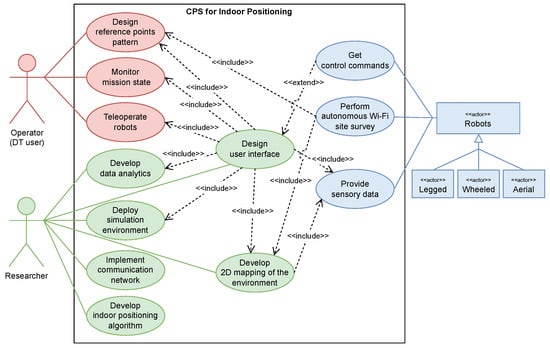
Figure 1.
A UML use-case diagram of the proposed system requirements.
Recognizing the problem statements and system requirements emphasizes the need for a holistic, advanced concept or solution that seamlessly integrates indoor positioning and digital twinning technologies. In this context, a potential solution to overcome these limitations involves developing a CPS architecture that integrates indoor positioning and digital twin technologies.
Figure 2 illustrates the proposed components of the cyber-physical wireless indoor positioning system, which involves three major elements: (1) constructing a physical space or twin, (2) developing a DT, and (3) establishing a digital tissue or digital communication network. Each of these components will be discussed in detail in the subsequent subsections.
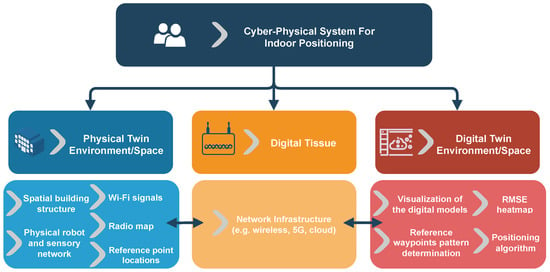
Figure 2.
Diagrammatic visual conceptual model and components of the cyber-physical wireless indoor positioning system, along with corresponding assets at the bottom level.
3.2.1. Physical Twin
The physical twin is the real-world physical environment, including the spatial building structure, physical instances of robots, sensors, and a sensory network that includes APs. The proposed physical twin is depicted in Figure 3. It consists of the physical environment of the RAICo1 facility in West Cumbria, UK, depicted in Figure 4, which spans approximately . The facility is divided into three separate, fenced areas, each equipped with representative equipment and tools. Furthermore, an Agilex Scout 2.0 four-wheeled, differential-drive ground robot is employed, which is equipped with encoders on its wheels and a 3D laser capable of perceiving its surroundings with a range of 100 m and a sampling rate of 1875 @ 10 Hz. In addition, the existing wireless infrastructure of the facility is utilized for Wi-Fi RSS measurement from the APs. In summary, the physical twin contains valuable information about the physical environment, such as Wi-Fi signals, a radio map, and RP locations, which are accessible through the robotic platform.
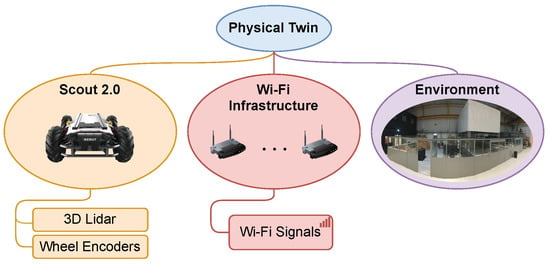
Figure 3.
Elements of physical twin.

Figure 4.
RAICo1 physical real-world environment and corresponding 2D map.
3.2.2. Digital Twin
A DT is a virtual replica or representation of a physical system that is synchronized with real-world assets and updated in near real-time [50]. When applied in the field of indoor positioning, DTs can lead to more efficient, scalable, and adaptable positioning systems by digitally representing physical systems and enabling interaction with humans. In this study, a 3D DT is developed by digitally modeling the physical environment and robots in a virtual or simulation environment to monitor the status of the robot while planning and executing its mission.
Furthermore, a graphical user interface (GUI) is integrated to facilitate interaction between users and the DT. This interactive interface assists in teleoperating the physical twin element of a mobile robot while simultaneously guiding the robot for a radio map and ground-truth locations, which are essential for developing fingerprinting-based techniques. This process involves making RP layout decisions based on the generated 2D dynamic occupancy map of the environment using the proposed interactive Wi-Fi site survey, which is detailed in the subsequent subsections.
3.2.3. DT and Graphical User Interface
The DT environment is developed based on the 3D building plan of the RAICo1 facility and the Agilex Scout 2.0 mobile robot shown in Figure 4a. Figure 5 presents an overview of the DT environment and GUI based on robot operating system (ROS) rqt [51]. The GUI provides multiple panels that support interactive Wi-Fi surveys and display live visualizations for analyzing and gaining insights into the robot’s actions and the overall system. Specifically, the GUI comprises the following windows:

Figure 5.
The DT environment together with the user interface.
- 1.
- Live mission monitoring and visualization window, which displays data collected from the physical twin.
- 2.
- RP generation parameter reconfiguration window.
- 3.
- Remote teleoperation window, which includes a virtual joystick and speedometer.
- 4.
- Positioning RMSE heat map window.
These windows allow for overseeing and coordinating the Wi-Fi site survey mission, as well as teleoperating the robot if necessary.
3.2.4. Interactive and Autonomous Wi-Fi Site Survey
Various methods have been proposed for conducting wireless site coverage surveys, including passive, active, and predictive approaches [52]. In this study, a passive survey approach is employed to identify and characterize the signal propagation of the existing Wi-Fi infrastructure in the environment. The survey process is managed by a human-in-the-loop using a GUI and autonomously executed by a mobile robot. This approach enables the construction of highly adaptable radio maps for new scenarios or changes in environmental conditions or AP locations, thereby overcoming the limitations of scalability and laborious data collection typically associated with fingerprint-based methods.
Figure 6 illustrates the stages involved in the interactive Wi-Fi site survey. The initial step includes digitally constructing the 2D spatial geometry of the area by exploring and perceiving the indoor environment. In this stage, a robot equipped with a laser sensor employs the simultaneous localization and mapping (SLAM) algorithm to scan and map the unknown environment. The robot can be either remotely teleoperated or directed to specific poses within the GUI.
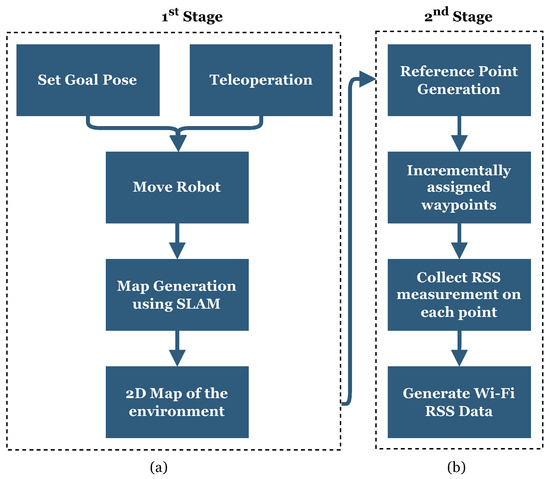
Figure 6.
Flowcharts of interactive Wi-Fi site survey steps: (a) 1st Stage: Generating the map of the environment; (b) 2nd Stage: Generating RSS data on designated waypoints on the generated map autonomously.
Once the mapping process is completed, the second stage involves distributing RPs throughout the mapped area using the RP generation tool [53]. This tool utilizes a dynamically adjusted marker pattern on a 2D grid map within the GUI, as shown in Figure 7. The RP generation tool provides adjustable dynamic parameters through the interface, including:

Figure 7.
Examples of interactive reference point generation for Wi-Fi site surveys are presented in various shapes and designs. (a) A triangle shape with three markers, one inner loop, and one reference point between two vertices. (b) A rectangular shape with four markers, two inner loops, and two reference points between two vertices. (c) A pentagon shape with five markers, three inner loops, and three reference points between two vertices. (d) A hexagon shape with six markers, four inner loops, and four reference points between two vertices.
- The number of interactive outer markers to draw the boundary for surveying.
- The number of loops inside the outer boundary.
- The number or distance of RPs between two vertices for each loop.
Depending on environmental factors and design knowledge, the determination of the number of markers used to shape the outer boundary, the number of inner loops, and the number of RPs is facilitated through a human-in-the-loop decision-making process guided by the DT. After determining the number and placement of RPs through the GUI, these RPs are incrementally assigned as waypoints to the robot for measuring RSS values. The robot navigates these RPs and collects RSS measurements at each point. Ultimately, this results in obtaining a Wi-Fi RSS radio map of the environment along the traveled routes in the designated waypoints.
3.2.5. Indoor Positioning Algorithm
Figure 8 presents the three main steps of a WLAN positioning system. The first step involves storing RSS-position values obtained during the Wi-Fi site survey, which are later used as separate training, validation, and test data sets. The next step is to process and prepare the data as a radio map for input into the positioning models. The final step of WLAN positioning involves training models and estimating the 2D spatial positions for the tracking problem.

Figure 8.
Overview of RSS-based WLAN positioning.
Deep learning methods are used to learn a model of the RSS-position relationship in order to accurately position a moving agent [54,55]. The methods utilized in this study are based on two deep learning techniques, namely multi-layer perceptron (MLP) and LSTM. These methods have been demonstrated to effectively tackle the Wi-Fi positioning problem as a regression task [55], with the root mean square error (RMSE) loss function () calculated by using Equation (1):
where is the estimation for RP, and is the ground-truth position for RP.
Two different LSTM models are used: Model 1 takes as input a sequence of temporally consecutive lagged RSS observations. Given a time step t and the lag size l, this is represented as given in Equation (2).
is the packing function with lag size parameter which transforms the sequence of RSS observations, , into multiple samples, where each sample has a specified number of time steps, l, and is reshaped into three dimensions to match the input dimensions expected by the LSTM model, as given in Equation (3):
Likewise, Model 2 accepts lagged RSS observations along with the predicted position, , from the previous time step as input, as given in Equation (4).
The deep network models used in this study are presented in detail in Ref. [55]. Consequently, deep wireless LAN positioning is formulated as a regression problem, and the performance of the model is evaluated based on the RMSE positioning error (Equation (12)).
3.2.6. Digital Tissue
Digital tissue is another essential component of CPS and refers to the communication network that enables data to be transferred between digital and physical twins. It facilitates real (or right)-time and resilient sharing of data. The digital tissue framework also manages system overload caused by excessive data through bandwidth management and/or smart utilization of shared data. As for communication across pairs, Figure 9 shows the communication infrastructure of the ROS Wi-Fi network [56]. The bandwidth consumption of the entire system was measured at approximately MB/s, equivalent to Mbps, which is lower than the available bandwidth estimated at around 60 Mbps during the experimental setup, as shown in Table 3. Therefore, no further techniques for bandwidth management or smart data management processes are considered.
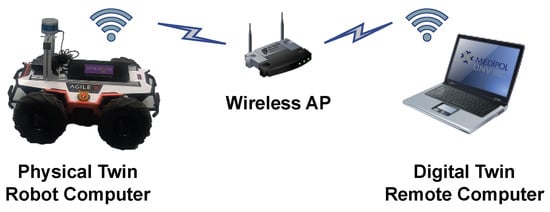
Figure 9.
Wi-Fi communication infrastructure.

Table 3.
Approximate max. total bandwidth requirements.
3.3. Overall Integration
In the preceding subsections, the main elements of the cyber-physical indoor positioning system were discussed, which were categorized into physical twins, DTs, and digital tissue components. Figure 10 presents an overview of the proposed component implementations, illustrating how data flows through the components and connects to the human operator.
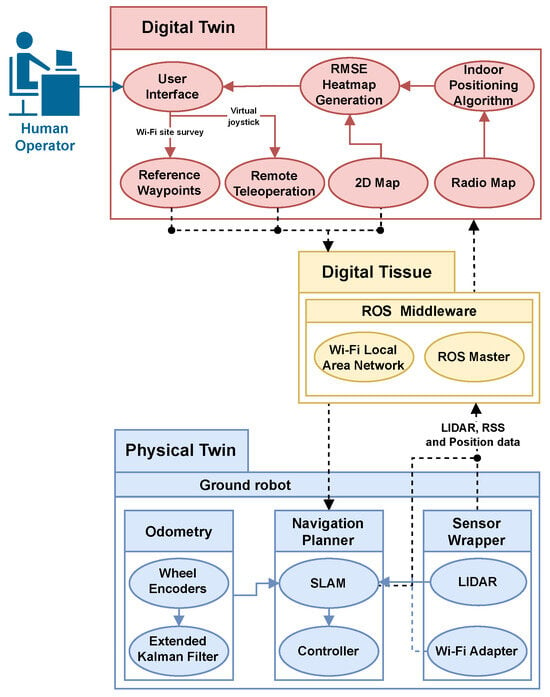
Figure 10.
Proposed cyber-physical system design implementation and data flow diagram.
The physical robot instance provides ground-truth position data, which is estimated using the Grid Mapping SLAM algorithm [57] with incoming laser scans. In addition, the physical twin provides LIDAR and Wi-Fi RSS data through the robot’s sensors. The RSS-position data sent from the physical twin is stored and used to create a radio map. By performing 2D interpolation on positioning errors, a continuous RMSE heat map is generated, which is displayed on a 2D map to visualize the performance of the Wi-Fi positioning system.
On the other hand, the DT user interface serves as the primary point of contact between human operators and the physical assets, executing the live teleoperation and displaying the current state of the physical robot. Furthermore, the RP pattern planner tool allows operators to provide commands for desired measurement points on the map. These points are assigned as waypoints or routes for the physical twin to navigate and take RSS measurements. This tool facilitates more complex and demanding applications by providing easy customization of survey behavior.
To ensure the bi-directional operability of the CPS, the ROS Middleware Wi-Fi network architecture is utilized. This architecture enables data reception and transmission between the physical twin and the DT.
4. Experimental Setup and Results
The calculation of RSS, as discussed in Ref. [16], presents a significant challenge due to the dynamic nature of RSS in uncertain environments with spatio-temporal constraints. Therefore, it can be challenging to fully characterize and apply the relationship between RSS and position using theoretical or simulation radio propagation models, such as the commonly used path loss and shadowing model described in Equation (5) [58] to general environments. To address this limitation, the proposed CPS approach is evaluated based on experimental RSS data collected from real environments in a DT case scenario. When experimental RSS data are unavailable, the received power formulation in Equation (5) includes , which represents the path loss exponent describing signal attenuation with distance, and , which accounts for additional losses or gains. Typically, both and are usually determined through experiments.
4.1. Data Collection
Experimental data sets for this study are collected at the RAICo1 facility, which houses fenced areas designated as Area 1, Area 2, and Area 3, as well as office areas and various test fields (Figure 4). The study relies on the existing WLAN communication infrastructure within the building, which orders the fixed number and placement of APs throughout the facility.
Data collection involves performing a current scan of all visible APs in the vicinity at each survey location. RSS measurements are collected using a laptop equipped with an Intel(R) Core(TM) i7-10750H Hex core processor, an Intel AX201/ Killer Wireless 1650 2 × 2 AC adapter, and an Ubuntu 20.04 operating system placed on the robot. RSS measurements are obtained through a publicly available Wi-Fi scan package [59], providing RSS measurements from Channels 1, 6, and 11 on the GHz band with a sampling rate of approximately 1 sample/s, in line with a similar setup described in the existing literature [16]. During each survey location, RSS measurements are expressed as integers in decibel-milliwatt (dBm) on a scale ranging from 0 (indicating the maximum achievable signal strength relative to 1 milliwatt) to (representing an unusable signal).
The number and placement of RPs are determined individually for each area, both for the training and test phases, through an interactive RP generator. Before starting the data collection process, the outer markers and waypoints are frozen to prevent human intervention. The layout and locations of RPs for training and test data sets are shown in Figure 11. These RPs are positioned to account for the presence of walls and other obstructions that may prevent navigating in certain areas. The spacing between RPs is set at m, and the number of RPs is distributed accordingly [55,60].
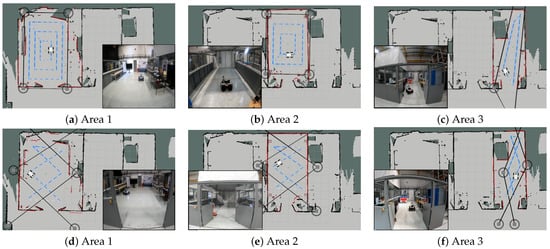
Figure 11.
Map of the experimental areas and designated measurement points visualized with white arrows indicating the position and orientation of reference points during both the training phases (a–c) and the testing phases (d–f).
During the training phase, the mobile robot remains stationary at each RP for approximately 10 s to collect RSS measurements from d detectable APs with a laptop placed on the mobile robot. The locations of RPs were generated using the SLAM algorithm. Therefore, the fingerprint matrix can be mathematically formulated considering d APs with n number of RSS samples received at the ith RP, as shown in Equation (6).
In the case of collecting test data, a sequential traversal of a route of test points is performed, reflecting the tracking scenario. At each point, while moving, an RSS sampling is measured with a sample rate of 1 sample/s. Table 4 presents the number of train and test points per area, along with the RP planner parameters (Figure 7) and the observed number of APs. This set is used to evaluate the performance of the positioning methods used.

Table 4.
Description of the number of reference points and APs for both train and test points across different areas, along with the reference point planner parameters.
4.2. Data Preparation
Indoor environments often encounter issues such as multipath fading, shadow fading, and path loss, which are common characteristics of wireless propagation. Multipath fading happens when there are multiple paths through which the signals travel, resulting from transmission, reflection, and diffraction off various surfaces [61]. Moreover, shadow fading and path loss conditions can occur due to changes in the environment or the movement of people. These channel impediments vary over time, which means that the radio map used during the training phase and the RSS values measured during the test phase (which is a different time frame than training) of the positioning algorithm may not be consistent. These inconsistencies can lead to a degradation in positioning accuracy because the position estimators rely on the radio map to develop their perception of the environment.
To mitigate the negative impact of environmental uncertainties, three consecutive steps denoted as are taken, as shown in Equation (7):
The first step is outlier threshold filtering, where is applied to the measurement samples taken from the same point to account for natural variations in RSS data. This step can be represented, as given in Equation (8):
where represents the filtered samples with n RSS measurements and d detectable APs. A defined threshold, , is used to identify outlier samples, which are then corrected by replacing them with the average of the samples collected at each RP from each AP.
Secondly, considering that the set of visible APs can change over time, in the event of no data reception at a particular AP, the missing values are filled with the average RSS values, , from that sequence. This process is denoted as and can be expressed as in Equation (9):
Lastly, the AP selection step, denoted as , is performed based on the statistics of the RSS sample distribution. The aim is to exclude a number (k) of APs that do not contribute significantly. These APs are identified by their mean RSS value, which is approximately dBm, along with a low standard deviation represented by . As a result, the representation is obtained in Equation (10), where n corresponds to the number of RSS measurements and represents the remaining APs after excluding the non-significant ones.
Eventually, a radio map is obtained from RPs, across the area, as given in Equation (11):
The resulting radio map serves as the input for training deep learning-based positioning models. As a result, two separate data sets (training and testing) are created, where of the training data is reserved as the validation data set, which will be used for parameter tuning.
4.3. Experimental Evaluation
One of the commonly used regression metrics, such as mean square error and mean absolute error, in indoor positioning algorithms to evaluate the performance of deep learning models is RMSE. While the RMSE loss function, as shown in Equation (1), is used during the training phase of a machine learning model, the positioning error is evaluated using the RMSE performance criteria, as indicated in Equation (12), on a test dataset. It quantifies the standard deviation of prediction errors, which shares the same unit of measurement as the actual positions, thus facilitating easier interpretation. This allows for a direct comparison of the error magnitude with the actual position unit, which is reported in meters.
4.4. Hyperparameter Optimization (HPO)
The process of tuning hyperparameter values, as shown in Table 5, is crucial for achieving efficient and accurate deep learning models. This process is often empirical and relies on the specific characteristics of the input dataset. Cross-validated grid search is employed to identify the best-performing hyperparameters within the following parameter grid:

Table 5.
MLP, LSTM Model 1, and Model 2 hyperparameters and cross-validated grid search results.
- Neurons/memory unit: [].
- Optimizer: [Adam, RMSprop].
- Learning rate: [].
- Batch size: [].
- Epochs: [].
This method involves evaluating all the required configurations by entirely testing various combinations of hyperparameters using the cross-validation splitting strategy. To account for the stochastic nature of the learning algorithms, empirical experimentation was conducted by running the algorithms of interest ten times. In each case, the parameters that yielded the smallest RMSE were selected, considering both the mean value and the standard deviation. The best hyperparameter values found by grid search for MLP, LSTM Model 1, and LSTM Model 2 models are presented in Table 5.
4.5. Experimental Results and Analysis
The comparison of positioning results and statistics (min, max, std) for various deep learning methods, obtained by running them 10 times in individual and combined test areas, is presented in Table 6. The performance of the positioning algorithms differs across each experimental area due to changes in the environment as seen in Table 6.

Table 6.
The positioning RMSE performance statistics were obtained by running each technique of interest (the LSTM Model 1, MLP, and LSTM Model 2) ten times. The results are reported in meters.
From Table 6, it can be concluded that the average performance degrades by up to m in LSTM Model 1, m in MLP, and m in LSTM Model 2. LSTM is capable of capturing the correlated RSS measurements and positions over time. Additionally, it indicates that the inclusion of additional position information in LSTM Model 2 has a positive effect on location estimation. Based on these results, as shown in Figure 12, LSTM Model 2 outperforms MLP and LSTM Model 1 in all areas except Area 1, where MLP performs better. Furthermore, LSTM Model 2 also significantly improves positioning accuracy, particularly in combined areas, Area (1, 2, 3).
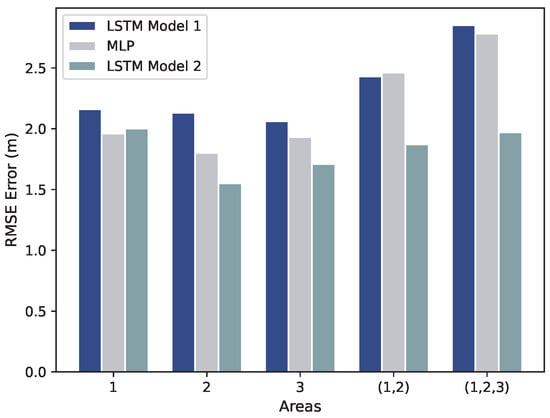
Figure 12.
Positioning performance of used algorithms per different mission areas.
Figure 13 depicts the positioning RMSE for varying numbers of test points (39, 34, and 26) across Areas 1, 2, and 3, respectively, considering different algorithms. The errors are represented by the z entries, extending from the xy-plane, where x and y correspond to the locations of RPs in the xy-plane. To enhance clarity in the visualization, discrete test errors are overlaid on a 2D map of the environment using a color-coded (blue–green–red) style spectrum. A continuous, complete error map is generated by applying a radial basis Gaussian function interpolation method [62] with parameters m and m. Here, represents an adjustable constant for the Gaussian function, while controls the smoothness of the approximation.
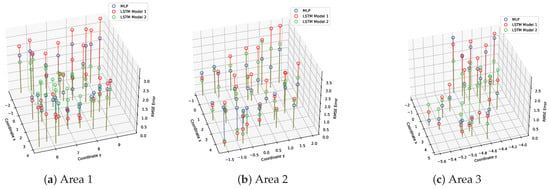
Figure 13.
Comparison of the individual positioning errors in meters obtained from various test points across different mission areas (a–c). The comparison is made between three models: MLP, LSTM Model 1, and LSTM Model 2.
Figure 14 displays the RMSE error heat map for each algorithm in the mission areas. In this representation, the blue color indicates lower RMSE values, while the red color indicates higher RMSE values. From Figure 14, it is shown that MLP and LSTM Model 1 have high RMSE in Area 3, while LSTM Model 2 achieves better results across Areas 1, 2, and 3. This improvement results from incorporating position information from the previous additional step within LSTM Model 2. Additionally, higher RMSE values are observed in areas with turns and boundary regions that separate areas with fences made of materials like metal, glass, and brenda. This is expected, as these areas and materials are more prone to error sources such as multipath propagation and shadowing.
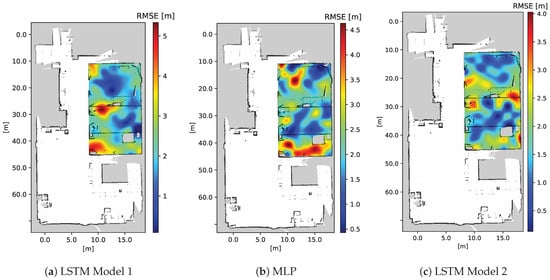
Figure 14.
Positioning RMSE heat map in meters for each positioning algorithm used. In this heat map, lower RMSE values are indicated by the blue color, while higher RMSE values are represented by the red color.
The cumulative density function (CDF) of the positioning RMSE errors for the positioning algorithms can be seen for both individual and combined mission areas, as depicted in Figure 15. Moreover, as can be seen from Figure 15d, the accuracy of positioning is significantly improved by employing the LSTM Model 2 algorithm for positioning performance compared to the other algorithms used in the combined Area (1, 2, 3). In order to provide an intuitive demonstration, the CDF values within 2 m of the positioning error of the techniques used are also given in Table 7. The CDF value within 2 m of the MLP algorithm is in Area 2, which is better than the other algorithms as can be seen in Table 7. On the other hand, LSTM Model 2 achieved the best results in all other areas, with values higher than .
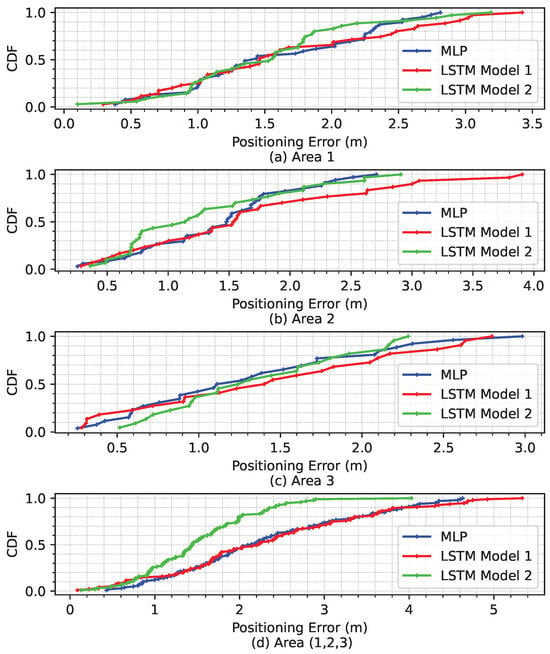
Figure 15.
CDFs of individual positioning errors in all areas for all models.

Table 7.
The probabilities of positioning errors for all models up to within 0–2 m in all areas.
5. Discussion and Conclusions
In this paper, we present the architecture of a cyber-physical wireless indoor positioning system and its components, aligning with the five properties that define a cognitive digital twin compared to the literature. These properties, outlined in Section 3.1, include scalability, situational awareness, minimization of reliance on human presence, precise and efficient data collection, and an efficient communication network. The proposed cyber-physical indoor positioning system demonstrated achievements to fill in the gaps in the requirements for cognitive digital twins of indoor positioning systems, as can be seen from Table 8.

Table 8.
Assessment of findings: Problem Statements vs. Experimental Results.
The integration of autonomous mobile data collectors guided by a digital twin showcased the adaptability and scalability of the fingerprinting-based systems for diverse indoor settings and challenging remote environments. The synchronized 3D digital twin environment and graphical user interface enhanced situational awareness, empowering human operators for informed decision-making. By successfully minimizing reliance on human presence through autonomous Wi-Fi site surveying, the system not only reduced labor costs but also improved safety. Moreover, the adoption of interactive reference point decision-making and the SLAM algorithm provided precise and efficient data collection, ultimately improving the accuracy of fingerprint-based positioning methods. The utilization of a defacto standard ROS framework for efficient communication further coordinated the system’s capabilities with its provision of standardized functionalities as an open-source middleware and flexible framework designed for the development of robot software that can easily scale and be interchanged.
The feasibility of the proposed CPS architecture is demonstrated by utilizing an autonomous robotic platform connected to a DT through a communication network that is coordinated by human-in-the-loop interaction. This approach enables remote operations and allows for regular re-adjusting or updating to effectively address the challenge of radio map obsolescence, aiming to mitigate the undesirable effects of time variations in RSS due to environmental conditions. It can also make remote operations safer and more efficient, particularly in environments where traditional fingerprinting systems may be ineffective or impractical, such as remote or hazardous locations. For instance, in nuclear facilities where human access is restricted or hazardous, the system can provide accurate positioning information without the need for personnel to physically enter the facility.
Furthermore, the proposed approach takes advantage of the good precision of deep learning models, resulting in localization performance comparable to that of prior studies [16,55]. Three deep neural network fingerprinting techniques have been developed for indoor WLAN-based positioning, using a radio map obtained from a real-world environment. Experimental results indicate that the LSTM Model 2 network architecture achieves the most accurate positioning performance in all areas except Area 1. Also, the MLP outperforms the LSTM Model 1 significantly in Area 2 and Area 3 with a CDF of more than within a 2 m error, while the LSTM Model 2 achieved CDF values of more than in all fields. This highlights the significance of incorporating additional position information in LSTM Model 2.
These results show the effectiveness of the proposed cyber-physical wireless indoor positioning approach, characterized by the application of dynamic Wi-Fi RSS surveying using autonomous mobile robots and the incorporation of human feedback through a graphical user interface. This shows its practical applicability and suitability for deployment in real-world scenarios. To improve positioning accuracy, additional information can be incorporated into the training of deep learning models. This information may include the receiver’s four orientations (north, south, east, and west), various signal characteristics (such as angle of arrival and time of arrival with multipath profile), and knowledge of the motion dynamics of the asset being tracked (e.g., human, robot, etc.).
Moreover, as a contingency plan for a potential issue of robot kidnapping, wherein the robot cannot estimate its location through SLAM to label the fingerprint location, a human-in-the-loop can engage in the process. They can take control to assist the robot in relocating itself through teleoperation, utilizing a graphical user interface through a digital twin. Once the robot is repositioned, it can resume its mission to collect the remaining fingerprint locations. In the absence of a human observer, the following kidnapping detection approaches [63,64] can be employed in SLAM to take action, such as defining recovery motions, especially in the case of a short-range kidnapping situation.
One limitation of the proposed CPS design is its potential inadequacy in addressing the resilience of the communication network and computing resource constraints in different environments. This can result in unexpected challenges, reliability issues, and performance problems during system implementation. To overcome these limitations, several strategies can be employed. Firstly, network design can be implemented to tolerate communication disruptions, enabling the system to connect and disconnect as needed. This approach ensures that the system can continue to function even in the event of temporary network interruptions. Secondly, prediction strategies can be employed to compensate for dropped or missed packets, thereby enhancing the system’s reliability. These strategies also allow the system to proactively adapt and mitigate the impact of communication disruptions. Furthermore, smart data management techniques, combined with data minimization approaches or computing at the edge, can be implemented to reduce bandwidth usage and optimize the system’s reliability within bandwidth and computing resource-constrained environments.
Moreover, further research by conducting long-distance experiments that utilize cloud or peer-to-peer network architectures can follow the current approach. Additionally, the a priori RSS heat maps generated from the radio map on DT can be leveraged to effectively deal with uncertainties in RSS measurements through proactive radio scene occupancy analysis. These informed channel planning decisions can lead to physical environment improvements in wireless coverage, such as the identification of wireless dead zones and interference sources, as well as areas with varying Wi-Fi signal strengths. These insights can then be combined with the adaptive determination of selecting RPs and APs used around a region of interest for an improvement in positioning error.
Author Contributions
Conceptualization, M.Z.K.; methodology, M.Z.K. and H.K.; software, M.Z.K. and H.K.; data curation, M.Z.K. and H.K.; writing—original draft preparation, M.Z.K.; writing—review and editing, H.K., S.W., and M.K.O.; funding acquisition, S.W. and M.K.O. All authors have read and agreed to the published version of the manuscript.
Funding
The research leading to these results has received funding from the ECSEL Joint Undertaking in collaboration with the European Union’s H2020 Framework Programme (H2020/2014-2020) Grant Agreement-101007321-StorAIge and National Authority TUBITAK with project ID 121N350 as well as EPSRC EP/P01366X/1 Robotics for Nuclear Environments.
Institutional Review Board Statement
Not applicable.
Informed Consent Statement
Not applicable.
Data Availability Statement
The data presented in this study are available on request from the corresponding author. The data are not publicly available due to privacy.
Conflicts of Interest
The authors declare no conflict of interest. The funders had no role in the design of the study, in the collection, analysis, or interpretation of data, in the writing of the manuscript, or in the decision to publish the results.
Correction Statement
This article has been republished with a minor correction to the Figure 11(f). This change does not affect the scientific content of the article.
References
- Zhao, Z.; Shen, L.; Yang, C.; Wu, W.; Zhang, M.; Huang, G.Q. IoT and digital twin enabled smart tracking for safety management. Comput. Oper. Res. 2021, 128, 105183. [Google Scholar] [CrossRef]
- Wu, W.; Shen, L.; Zhao, Z.; Li, M.; Huang, G.Q. Industrial IoT and long short-term memory network enabled genetic indoor tracking for factory logistics. IEEE Trans. Ind. Inform. 2022, 18, 7537–7548. [Google Scholar] [CrossRef]
- Tsai, M.H.; Pan, C.S.; Wang, C.W.; Chen, J.M.; Kuo, C.B. RFID medical equipment tracking system based on a location-based service technique. J. Med. Biol. Eng. 2019, 39, 163–169. [Google Scholar] [CrossRef]
- Sangwan, R.S.; Qiu, R.G.; Jessen, D. Using RFID tags for tracking patients, charts and medical equipment within an integrated health delivery network. In Proceedings of the 2005 IEEE Networking, Sensing and Control, Tucson, AZ, USA, 19–22 March 2005; IEEE: Pisctaway, NJ, USA, 2005; pp. 1070–1074. [Google Scholar]
- Borrazzo, M.; D’Ambrosio, G.; Scarano, V.; Spagnuolo, C. TraceMeNow: An Open-Source Software Framework for Indoor Localization Applications. In Proceedings of the International Conference on Indoor Positioning and Indoor Navigation-IPIN-WiP, Lloret de Mar, Spain, 29 November–2 December 2021. [Google Scholar]
- Belka, R.; Deniziak, R.S.; Łukawski, G.; Pięta, P. BLE-based indoor tracking system with overlapping-resistant IoT solution for tourism applications. Sensors 2021, 21, 329. [Google Scholar] [CrossRef] [PubMed]
- Khruahong, S.; Kong, X.; Sandrasegaran, K.; Liu, L. Multi-level indoor navigation ontology for high assurance location-based services. In Proceedings of the 2017 IEEE 18th International Symposium on High Assurance Systems Engineering, Singapore, 12–14 January 2017; IEEE: Piscataway, NJ, USA, 2017; pp. 128–131. [Google Scholar]
- Shin, H.; Chon, Y.; Kim, Y.; Cha, H. A participatory service platform for indoor location-based services. IEEE Pervasive Comput. 2015, 14, 62–69. [Google Scholar] [CrossRef]
- Plataniotis, K.; Regazzoni, C. Visual-centric surveillance networks and services [Guest Editorial]. IEEE Signal Process. Mag. 2005, 22, 12–15. [Google Scholar] [CrossRef]
- Harter, A.; Hopper, A. A distributed location system for the active office. IEEE Netw. 1994, 8, 62–70. [Google Scholar] [CrossRef]
- Tamas, L.; Lazea, G.; Popa, M.; Szoke, I.; Majdik, A. Laser based localization techniques for indoor mobile robots. In Proceedings of the 2009 Advanced Technologies for Enhanced Quality of Life, Iasi, Romania, 22–26 July 2009; IEEE: Piscataway, NJ, USA, 2009; pp. 169–170. [Google Scholar]
- Hazas, M.; Hopper, A. Broadband ultrasonic location systems for improved indoor positioning. IEEE Trans. Mob. Comput. 2006, 5, 536–547. [Google Scholar] [CrossRef]
- Nagah Amr, M.; ELAttar, H.M.; Abd El Azeem, M.H.; El Badawy, H. An enhanced indoor positioning technique based on a novel received signal strength indicator distance prediction and correction model. Sensors 2021, 21, 719. [Google Scholar] [CrossRef]
- Poulose, A.; Han, D.S. UWB indoor localization using deep learning LSTM networks. Appl. Sci. 2020, 10, 6290. [Google Scholar] [CrossRef]
- Yang, C.; Shao, H.R. WiFi-based indoor positioning. IEEE Commun. Mag. 2015, 53, 150–157. [Google Scholar] [CrossRef]
- Kushki, A. A Cognitive Radio Tracking System for Indoor Environments. Ph.D Thesis, University of Toronto, Toronto, ON, Canada, 2008. [Google Scholar]
- Figuera, C.; Rojo-Álvarez, J.L.; Mora-Jiménez, I.; Guerrero-Curieses, A.; Wilby, M.; Ramos-López, J. Time-space sampling and mobile device calibration for WiFi indoor location systems. IEEE Trans. Mob. Comput. 2011, 10, 913–926. [Google Scholar] [CrossRef]
- Park, J.g.; Curtis, D.; Teller, S.; Ledlie, J. Implications of device diversity for organic localization. In Proceedings of the 2011 Proceedings IEEE INFOCOM, Shanghai, China, 10–15 April 2011; IEEE: Piscataway, NJ, USA, 2011; pp. 3182–3190. [Google Scholar]
- Haeberlen, A.; Flannery, E.; Ladd, A.M.; Rudys, A.; Wallach, D.S.; Kavraki, L.E. Practical robust localization over large-scale 802. 11 wireless networks. In Proceedings of the 10th Annual International Conference on Mobile Computing and Networking, Philadelphia, PA, USA, 26 September–1 October 2004; pp. 70–84. [Google Scholar]
- Dong, F.; Chen, Y.; Liu, J.; Ning, Q.; Piao, S. A calibration-free localization solution for handling signal strength variance. In Proceedings of the Mobile Entity Localization and Tracking in GPS-Less Environnments: Second International Workshop, MELT 2009, Orlando, FL, USA, 30 September 2009; Springer: Berlin/Heidelberg, Germany, 2009; pp. 79–90. [Google Scholar]
- Kjærgaard, M.B. Indoor location fingerprinting with heterogeneous clients. Pervasive Mob. Comput. 2011, 7, 31–43. [Google Scholar] [CrossRef]
- Zheng, Z.; Chen, Y.; He, T.; Li, F.; Chen, D. Weight-RSS: A calibration-free and robust method for WLAN-Based indoor positioning. Int. J. Distrib. Sens. Netw. 2015, 11, 573582. [Google Scholar] [CrossRef]
- Zou, H.; Huang, B.; Lu, X.; Jiang, H.; Xie, L. Standardizing location fingerprints across heterogeneous mobile devices for indoor localization. In Proceedings of the 2016 IEEE Wireless Communications and Networking Conference, Doha, Qatar, 3–6 April 2016; IEEE: Piscataway, NJ, USA, 2016; pp. 1–6. [Google Scholar]
- Pandey, A.; Vamsi, R.; Kumar, S. Handling device heterogeneity and orientation using multistage regression for GMM based localization in IoT networks. IEEE Access 2019, 7, 144354–144365. [Google Scholar] [CrossRef]
- Bahl, P.; Padmanabhan, V.N. RADAR: An in-building RF-based user location and tracking system. In Proceedings of the 2000 IEEE 19th Annual Joint Conference: INFOCOM, IEEE Computer and Communications Societies, Tel Aviv, Israel, 26–30 March 2000; IEEE: Piscataway, NJ, USA, 2000; Volume 2, pp. 775–784. [Google Scholar]
- Subedi, S.; Pyun, J.Y. Practical fingerprinting localization for indoor positioning system by using beacons. J. Sensors 2017, 2017, 9742170. [Google Scholar] [CrossRef]
- Halvarsson, M.; Qin, J. Populating a Database to be used with an Indoor Positioning System. Bachelor’s Thesis, KTH Royal Institute of Technology, Stockholm, Sweden, 2022. [Google Scholar]
- Viel, B.; Asplund, M. Why is fingerprint-based indoor localization still so hard? In Proceedings of the 2014 IEEE International Conference on Pervasive Computing and Communication Workshops, Budapest, Hungary, 24–28 March 2014; IEEE: Piscataway, NJ, USA, 2014; pp. 443–448. [Google Scholar]
- Bhardwaj, S.; Ozcelebi, T.; Lukkien, J.J.; Lee, K.M. Smart Space Concepts, Properties and Architectures. IEEE Access 2018, 6, 70088–70112. [Google Scholar] [CrossRef]
- Correa, A.; Barcelo, M.; Morell, A.; Vicario, J.L. A review of pedestrian indoor positioning systems for mass market applications. Sensors 2017, 17, 1927. [Google Scholar] [CrossRef]
- Roxin, A.; Gaber, J.; Wack, M.; Nait-Sidi-Moh, A. Survey of wireless geolocation techniques. In Proceedings of the 2007 IEEE Globecom Workshops, Washington, DC, USA, 26–30 November 2007; IEEE: Piscataway, NJ, USA, 2007; pp. 1–9. [Google Scholar]
- Xiong, G.; Anwar, N.; Ye, P.; Chen, X.; Zhao, H.; Lv, Y.; Zhu, F.; Zhang, H.; Zhou, X.; Liu, R.W. Cyber–Physical–Social Systems for Smart City. In Cyber-Physical-Human Systems: Fundamentals and Applications; Wiley: Hoboken, NJ, USA, 2023; pp. 511–542. [Google Scholar] [CrossRef]
- GOV.UK. Enabling a National Cyber-Physical Infrastructure to Catalyse Innovation. Technical Report. 2023. Available online: https://www.gov.uk/government/consultations/enabling-a-national-cyber-physical-infrastructure-to-catalyse-innovation (accessed on 21 June 2023).
- Fuller, A.; Fan, Z.; Day, C.; Barlow, C. Digital twin: Enabling technologies, challenges and open research. IEEE Access 2020, 8, 108952–108971. [Google Scholar] [CrossRef]
- Lou, P.; Zhao, Q.; Zhang, X.; Li, D.; Hu, J. Indoor Positioning System with UWB Based on a Digital Twin. Sensors 2022, 22, 5936. [Google Scholar] [CrossRef]
- Farahsari, P.S.; Farahzadi, A.; Rezazadeh, J.; Bagheri, A. A Survey on Indoor Positioning Systems for IoT-based Applications. IEEE Internet Things J. 2022, 9, 7680–7699. [Google Scholar] [CrossRef]
- Lashkari, B.; Rezazadeh, J.; Farahbakhsh, R.; Sandrasegaran, K. Crowdsourcing and sensing for indoor localization in IoT: A review. IEEE Sens. J. 2018, 19, 2408–2434. [Google Scholar] [CrossRef]
- Capgemini. Capgemini. Digital Twin in Finance. Technical Report. 2023. Available online: https://www.capgemini.com/solutions/digital-twin-for-finance/ (accessed on 21 June 2023).
- Pauley. Pauley. Digital Twins. Technical Report. 2023. Available online: https://website2019.pauley.co.uk/products/digital-twin/ (accessed on 21 June 2023).
- Jacobs. Jacobs. Digital Twin Technologies. Technical Report. 2023. Available online: https://www.jacobs.com/newsroom/news/how-digital-twin-and-analytics-improve-operations-minimize-costs (accessed on 21 June 2023).
- BAE Systems. Digital Twin—Testing Real World Performance in the Digital World. Technical Report. BAE Systems. 2023. Available online: https://www.baesystems.com/en/feature/digital-twin-testing-real-world-performance-in-the-digital-world (accessed on 21 June 2023).
- Twinzo. Twinzo. Digital Twin App. Technical Report. 2023. Available online: https://www.twinzo.eu/ (accessed on 21 June 2023).
- D’Aloia, M.; Longo, A.; Guadagno, G.; Pulpito, M.; Fornarelli, P.; Laera, P.N.; Manni, D.; Rizzi, M. IoT Indoor Localization with AI Technique. In Proceedings of the 2020 IEEE International Workshop on Metrology for Industry 4.0 & IoT, Rome, Italy, 3–5 June 2020; IEEE: Piscataway, NJ, USA, 2020; pp. 654–658. [Google Scholar]
- Cakan, E.; Şahin, A.; Nakip, M.; Rodoplu, V. Multi-layer perceptron decomposition architecture for mobile IoT indoor positioning. In Proceedings of the 2021 IEEE 7th World Forum on Internet of Things (WF-IoT), New Orleans, LA, USA, 14–31 July 2021; IEEE: Piscataway, NJ, USA, 2021; pp. 253–257. [Google Scholar]
- Yutan, Z.; Gengbao, H. Exploration and analysis of intelligent IoT based on the difficult environment of warehouse indoor positioning. In Proceedings of the 2022 IEEE Asia-Pacific Conference on Image Processing, Electronics and Computers (IPEC), Dalian, China, 14–16 April 2022; IEEE: Piscataway, NJ, USA, 2022; pp. 418–421. [Google Scholar]
- Mitchell, D.; Blanche, J.; Zaki, O.; Roe, J.; Kong, L.; Harper, S.; Robu, V.; Lim, T.; Flynn, D. Symbiotic System of Systems Design for Safe and Resilient Autonomous Robotics in Offshore Wind Farms. IEEE Access 2021, 9, 141421–141452. [Google Scholar] [CrossRef]
- de Kerckhove, D.; Saracco, R. The Future of Digital Twins; Digital Reality, an IEEE Future Directions: eBook; IEEE: Piscataway, NJ, USA, 2021. [Google Scholar]
- Terán, M.; Aranda, J.; Carrillo, H.; Mendez, D.; Parra, C. IoT-based system for indoor location using bluetooth low energy. In Proceedings of the 2017 IEEE Colombian Conference on Communications and Computing, Cartagena, Colombia, 16–18 August 2017; IEEE: Piscataway, NJ, USA, 2017; pp. 1–6. [Google Scholar]
- Spachos, P.; Plataniotis, K.N. BLE beacons for indoor positioning at an interactive IoT-based smart museum. IEEE Syst. J. 2020, 14, 3483–3493. [Google Scholar] [CrossRef]
- Rasheed, A.; San, O.; Kvamsdal, T. Digital twin: Values, challenges and enablers from a modeling perspective. IEEE Access 2020, 8, 21980–22012. [Google Scholar] [CrossRef]
- Duan, F.; Li, W.; Tan, Y. ROS Debugging. In Intelligent Robot: Implementation and Applications; Springer: Berlin/Heidelberg, Germany, 2023; pp. 71–92. [Google Scholar]
- Jackman, S.M.; Swartz, M.; Burton, M.; Head, T.W. CWDP Certified Wireless Design Professional Official Study Guide: Exam PW0-250; John Wiley & Sons: Hoboken, NJ, USA, 2011. [Google Scholar]
- Nouri Rahmat Abadi, B.; West, A.; Nancekievill, M.; Ballard, C.; Lennox, B.; Marjanovic, O.; Groves, K. CARMA II: A ground vehicle for autonomous surveying of alpha, beta and gamma radiation. Front. Robot. AI 2023, 10, 1137750. [Google Scholar] [CrossRef]
- Hoang, M.T.; Yuen, B.; Dong, X.; Lu, T.; Westendorp, R.; Reddy, K. Recurrent neural networks for accurate RSSI indoor localization. IEEE Internet Things J. 2019, 6, 10639–10651. [Google Scholar] [CrossRef]
- Karakusak, M.Z.; Kivrak, H.; Ates, H.F.; Ozdemir, M.K. RSS-Based Wireless LAN Indoor Localization and Tracking Using Deep Architectures. Big Data Cogn. Comput. 2022, 6, 84. [Google Scholar] [CrossRef]
- Anggraeni, P.; Mrabet, M.; Defoort, M.; Djemai, M. Development of a wireless communication platform for multiple-mobile robots using ROS. In Proceedings of the 2018 6th International Conference on Control Engineering & Information Technology (CEIT), Istanbul, Turkey, 25–27 October 2018; IEEE: Piscataway, NJ, USA, 2018; pp. 1–6. [Google Scholar]
- Grisetti, G.; Stachniss, C.; Burgard, W. Improved Techniques for Grid Mapping With Rao-Blackwellized Particle Filters. IEEE Trans. Robot. 2007, 23, 34–46. [Google Scholar] [CrossRef]
- Goldsmith, A. Wireless Communications; Cambridge University Press: Cambridge, UK, 2005. [Google Scholar]
- Berkvens, R. wifi_scan Package. GitHub repository. 2013. Available online: https://github.com/RafBerkvens/wifi_scan (accessed on 15 December 2023).
- Alsindi, N.A.; Alavi, B.; Pahlavan, K. Measurement and Modeling of Ultrawideband TOA-Based Ranging in Indoor Multipath Environments. IEEE Trans. Veh. Technol. 2009, 58, 1046–1058. [Google Scholar] [CrossRef]
- Metreaud, L.T. Rf Isolated Real-Time Multipath Testbed for Performance Analysis of wlans. Master’s Thesis, Worcester Polytechnic Institute, Electrical and Computer Engineering, Worcester, MA, USA, 2006. [Google Scholar]
- Wright, G.B. Radial Basis Function Interpolation: Numerical and Analytical Developments; University of Colorado at Boulder: Boulder, CO, USA, 2003. [Google Scholar]
- Ismail, Z.H.; Bukhori, I. Efficient Detection of Robot Kidnapping in Range Finder-Based Indoor Localization Using Quasi-Standardized 2D Dynamic Time Warping. Appl. Sci. 2021, 11, 1580. [Google Scholar] [CrossRef]
- Tian, Y.; Ma, S. Probabilistic double guarantee kidnapping detection in SLAM. Robot. Biomimetics 2016, 3, 20. [Google Scholar] [CrossRef] [PubMed]
Disclaimer/Publisher’s Note: The statements, opinions and data contained in all publications are solely those of the individual author(s) and contributor(s) and not of MDPI and/or the editor(s). MDPI and/or the editor(s) disclaim responsibility for any injury to people or property resulting from any ideas, methods, instructions or products referred to in the content. |
© 2023 by the authors. Licensee MDPI, Basel, Switzerland. This article is an open access article distributed under the terms and conditions of the Creative Commons Attribution (CC BY) license (https://creativecommons.org/licenses/by/4.0/).